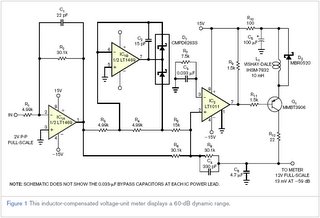VU Meter
by
An audio volume-unit meter displays peak-related audio amplitudes to aid in accurately setting recording levels or for displaying an amplifier's operating conditions. A simple diode and capacitor network provides a classic volume-unit meter's peak-weighted response, but the circuit typically limits response to about 23 dB of displayable dynamic range, and the meter suffers from errors that its pointer's inertia and mechanical "ballistics" introduce. Contemporary displays eliminate the inertia problem by using arrays of lighted elements to form bar graphs, but any shortcomings in response and accuracy characteristics now shift to the signal-processing domain. You can use DSP techniques and applied mathematics to replicate a meter's functions in firmware, but this approach gets relatively expensive if the device doesn't already include DSP functions to spare.
An inexpensive analog meter's weakness remains its peak-hold element, a capacitor that must charge quickly to accommodate large signals and accurately for small signals—two mutually exclusive goals. In addition, the nonideal characteristics of the diodes for full-wave rectification and peak-hold functions also limit an analog volume-unit meter's dynamic range. Preserving 20 dB of display dynamics and monitoring signal levels that can vary over a 40-dB range, which is typical in consumer electronics, call for a circuit with a dynamic range on the order of 60 dB.
In most instances, traditional circuits fail to simultaneously provide the intended accuracy and slew rate, particularly at low signal levels over a wide dynamic range. The circuit below offers a simple configuration that delivers high accuracy over a dynamic range that exceeds 60 dB and provides the rapid-attack/slow-decay characteristics that a high-quality display requires.
Schematic (click to enlarge):
The heart of the circuit is a Linear Technology LT1011 comparator, IC2, which monitors the difference between the incoming signal's amplitude and the peak-detected output. It also delivers charging current to a 4.7-µF hold capacitor, C6, whenever the state of its charge is too low. Unfortunately, the input-to-output delay inherent in comparators and nonlinear amplifiers determines the minimum output-pulse width. If the hold capacitor charges quickly to track large input bursts, the minimum charge step must greatly exceed the level of small signals and thus limits the dynamic range.Inductor L1 solves the capacitor-response problem by providing an adaptively variable source of charging current. Adding a 10-mH inductor limits the maximum current rate when the comparator generates narrow pulses, thus reducing the minimum charging amplitude step to a smaller level of 1 mV or less. For wider charging pulses, the current automatically ramps up to higher levels to provide the desired high slewing rate. The minimum charge step is essentially proportional to the signal-step size, ensuring a constant relative accuracy of better than 1 dB over a 60-dB signal range. A signal level of –59 dB corresponds to a 13-mV input, and a meter-scale factor of 0 dB of 2V peak corresponds to the input level necessary for a typical gain-of-20 audio power amplifier to deliver 100W rms into an 8Ω load, or approximately 40V peak output.
The circuit also includes two operational-amplifier stages based on Linear Technology's high-accuracy LT1469 dual op amp. The first stage, IC1A, provides gain of a factor of six in this example, so that a 2V input peak provides a 12V output. The second op-amp stage, IC1B, forms a precision inverting half-wave rectifier. The outputs from IC1A and IC1B and the positive-peak-detected voltage across C6 combine at IC2's input to provide a zero-crossing threshold to the comparator. When its input falls below 0V, IC2's output switches on Q1 and delivers charge to C6 until the voltage across C6 reaches or slightly exceeds the amplified audio voltage. The feedback network comprising R8 and C4 provides an optimal volume-unit-metering discharge.
Source WebEE





0 Comments:
Post a Comment
<< Home